Jianxin Wang
Diversity-Guided MLP Reduction for Efficient Large Vision Transformers
Jun 10, 2025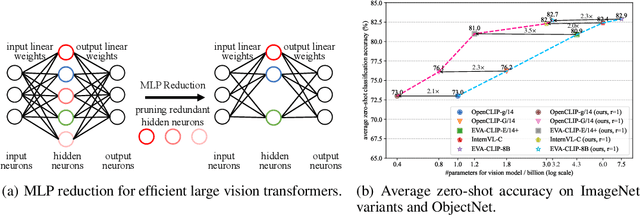
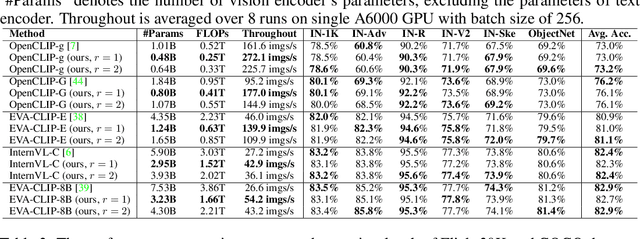
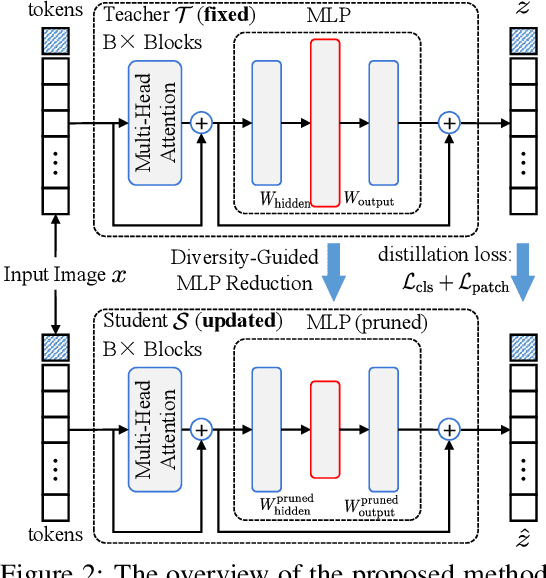
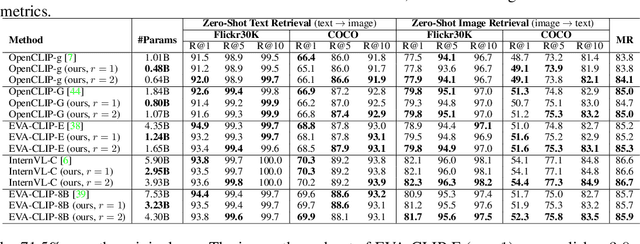
Abstract:Transformer models achieve excellent scaling property, where the performance is improved with the increment of model capacity. However, large-scale model parameters lead to an unaffordable cost of computing and memory. We analyze popular transformer architectures and find that multilayer perceptron (MLP) modules take up the majority of model parameters. To this end, we focus on the recoverability of the compressed models and propose a Diversity-Guided MLP Reduction (DGMR) method to significantly reduce the parameters of large vision transformers with only negligible performance degradation. Specifically, we conduct a Gram-Schmidt weight pruning strategy to eliminate redundant neurons of MLP hidden layer, while preserving weight diversity for better performance recover during distillation. Compared to the model trained from scratch, our pruned model only requires 0.06\% data of LAION-2B (for the training of large vision transformers) without labels (ImageNet-1K) to recover the original performance. Experimental results on several state-of-the-art large vision transformers demonstrate that our method achieves a more than 57.0\% parameter and FLOPs reduction in a near lossless manner. Notably, for EVA-CLIP-E (4.4B), our method accomplishes a 71.5\% parameter and FLOPs reduction without performance degradation. The source code and trained weights are available at https://github.com/visresearch/DGMR.
Multiple Object Stitching for Unsupervised Representation Learning
Jun 09, 2025Abstract:Contrastive learning for single object centric images has achieved remarkable progress on unsupervised representation, but suffering inferior performance on the widespread images with multiple objects. In this paper, we propose a simple but effective method, Multiple Object Stitching (MOS), to refine the unsupervised representation for multi-object images. Specifically, we construct the multi-object images by stitching the single object centric ones, where the objects in the synthesized multi-object images are predetermined. Hence, compared to the existing contrastive methods, our method provides additional object correspondences between multi-object images without human annotations. In this manner, our method pays more attention to the representations of each object in multi-object image, thus providing more detailed representations for complicated downstream tasks, such as object detection and semantic segmentation. Experimental results on ImageNet, CIFAR and COCO datasets demonstrate that our proposed method achieves the leading unsupervised representation performance on both single object centric images and multi-object ones. The source code is available at https://github.com/visresearch/MultipleObjectStitching.
BiBLDR: Bidirectional Behavior Learning for Drug Repositioning
May 29, 2025Abstract:Drug repositioning aims to identify potential new indications for existing drugs to reduce the time and financial costs associated with developing new drugs. Most existing deep learning-based drug repositioning methods predominantly utilize graph-based representations. However, graph-based drug repositioning methods struggle to perform effective inference in cold-start scenarios involving novel drugs because of the lack of association information with the diseases. Unlike traditional graph-based approaches, we propose a bidirectional behavior learning strategy for drug repositioning, known as BiBLDR. This innovative framework redefines drug repositioning as a behavior sequential learning task to capture drug-disease interaction patterns. First, we construct bidirectional behavioral sequences based on drug and disease sides. The consideration of bidirectional information ensures a more meticulous and rigorous characterization of the behavioral sequences. Subsequently, we propose a two-stage strategy for drug repositioning. In the first stage, we construct prototype spaces to characterize the representational attributes of drugs and diseases. In the second stage, these refined prototypes and bidirectional behavior sequence data are leveraged to predict potential drug-disease associations. Based on this learning approach, the model can more robustly and precisely capture the interactive relationships between drug and disease features from bidirectional behavioral sequences. Extensive experiments demonstrate that our method achieves state-of-the-art performance on benchmark datasets. Meanwhile, BiBLDR demonstrates significantly superior performance compared to previous methods in cold-start scenarios. Our code is published in https://github.com/Renyeeah/BiBLDR.
PartInstruct: Part-level Instruction Following for Fine-grained Robot Manipulation
May 27, 2025Abstract:Fine-grained robot manipulation, such as lifting and rotating a bottle to display the label on the cap, requires robust reasoning about object parts and their relationships with intended tasks. Despite recent advances in training general-purpose robot manipulation policies guided by language instructions, there is a notable lack of large-scale datasets for fine-grained manipulation tasks with part-level instructions and diverse 3D object instances annotated with part-level labels. In this work, we introduce PartInstruct, the first large-scale benchmark for training and evaluating fine-grained robot manipulation models using part-level instructions. PartInstruct comprises 513 object instances across 14 categories, each annotated with part-level information, and 1302 fine-grained manipulation tasks organized into 16 task classes. Our training set consists of over 10,000 expert demonstrations synthesized in a 3D simulator, where each demonstration is paired with a high-level task instruction, a chain of base part-based skill instructions, and ground-truth 3D information about the object and its parts. Additionally, we designed a comprehensive test suite to evaluate the generalizability of learned policies across new states, objects, and tasks. We evaluated several state-of-the-art robot manipulation approaches, including end-to-end vision-language policy learning and bi-level planning models for robot manipulation on our benchmark. The experimental results reveal that current models struggle to robustly ground part concepts and predict actions in 3D space, and face challenges when manipulating object parts in long-horizon tasks.
DDO: Dual-Decision Optimization via Multi-Agent Collaboration for LLM-Based Medical Consultation
May 24, 2025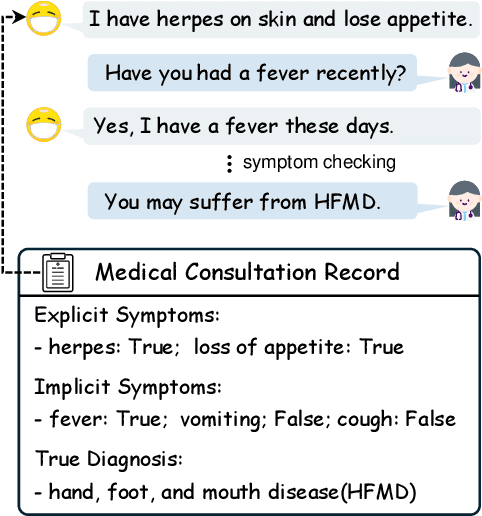
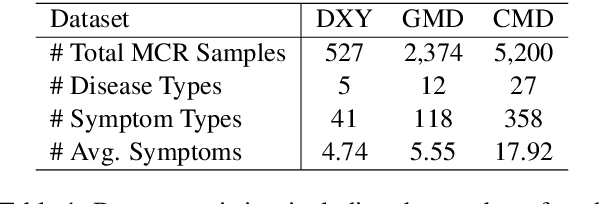
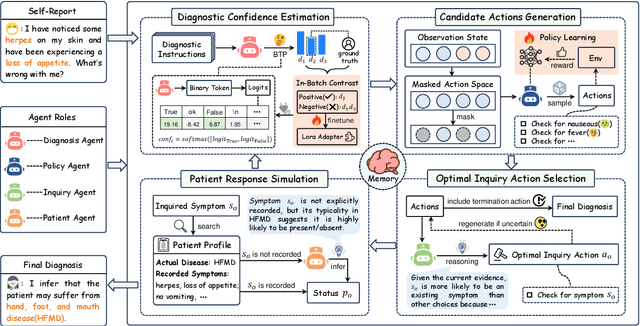
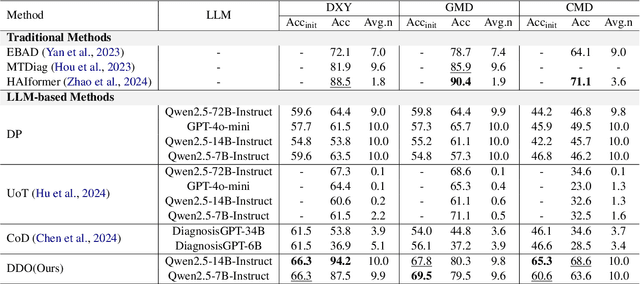
Abstract:Large Language Models (LLMs) demonstrate strong generalization and reasoning abilities, making them well-suited for complex decision-making tasks such as medical consultation (MC). However, existing LLM-based methods often fail to capture the dual nature of MC, which entails two distinct sub-tasks: symptom inquiry, a sequential decision-making process, and disease diagnosis, a classification problem. This mismatch often results in ineffective symptom inquiry and unreliable disease diagnosis. To address this, we propose \textbf{DDO}, a novel LLM-based framework that performs \textbf{D}ual-\textbf{D}ecision \textbf{O}ptimization by decoupling and independently optimizing the the two sub-tasks through a collaborative multi-agent workflow. Experiments on three real-world MC datasets show that DDO consistently outperforms existing LLM-based approaches and achieves competitive performance with state-of-the-art generation-based methods, demonstrating its effectiveness in the MC task.
CheXLearner: Text-Guided Fine-Grained Representation Learning for Progression Detection
May 11, 2025



Abstract:Temporal medical image analysis is essential for clinical decision-making, yet existing methods either align images and text at a coarse level - causing potential semantic mismatches - or depend solely on visual information, lacking medical semantic integration. We present CheXLearner, the first end-to-end framework that unifies anatomical region detection, Riemannian manifold-based structure alignment, and fine-grained regional semantic guidance. Our proposed Med-Manifold Alignment Module (Med-MAM) leverages hyperbolic geometry to robustly align anatomical structures and capture pathologically meaningful discrepancies across temporal chest X-rays. By introducing regional progression descriptions as supervision, CheXLearner achieves enhanced cross-modal representation learning and supports dynamic low-level feature optimization. Experiments show that CheXLearner achieves 81.12% (+17.2%) average accuracy and 80.32% (+11.05%) F1-score on anatomical region progression detection - substantially outperforming state-of-the-art baselines, especially in structurally complex regions. Additionally, our model attains a 91.52% average AUC score in downstream disease classification, validating its superior feature representation.
FIND: Fine-grained Information Density Guided Adaptive Retrieval-Augmented Generation for Disease Diagnosis
Feb 20, 2025Abstract:Retrieval-Augmented Large Language Models (LLMs), which integrate external knowledge into LLMs, have shown remarkable performance in various medical domains, including clinical diagnosis. However, existing RAG methods struggle to effectively assess task difficulty to make retrieval decisions, thereby failing to meet the clinical requirements for balancing efficiency and accuracy. So in this paper, we propose FIND (\textbf{F}ine-grained \textbf{In}formation \textbf{D}ensity Guided Adaptive RAG), a novel framework that improves the reliability of RAG in disease diagnosis scenarios. FIND incorporates a fine-grained adaptive control module to determine whether retrieval is necessary based on the information density of the input. By optimizing the retrieval process and implementing a knowledge filtering module, FIND ensures that the retrieval is better suited to clinical scenarios. Experiments on three Chinese electronic medical record datasets demonstrate that FIND significantly outperforms various baseline methods, highlighting its effectiveness in clinical diagnosis tasks.
Glioma Multimodal MRI Analysis System for Tumor Layered Diagnosis via Multi-task Semi-supervised Learning
Jan 29, 2025



Abstract:Gliomas are the most common primary tumors of the central nervous system. Multimodal MRI is widely used for the preliminary screening of gliomas and plays a crucial role in auxiliary diagnosis, therapeutic efficacy, and prognostic evaluation. Currently, the computer-aided diagnostic studies of gliomas using MRI have focused on independent analysis events such as tumor segmentation, grading, and radiogenomic classification, without studying inter-dependencies among these events. In this study, we propose a Glioma Multimodal MRI Analysis System (GMMAS) that utilizes a deep learning network for processing multiple events simultaneously, leveraging their inter-dependencies through an uncertainty-based multi-task learning architecture and synchronously outputting tumor region segmentation, glioma histological subtype, IDH mutation genotype, and 1p/19q chromosome disorder status. Compared with the reported single-task analysis models, GMMAS improves the precision across tumor layered diagnostic tasks. Additionally, we have employed a two-stage semi-supervised learning method, enhancing model performance by fully exploiting both labeled and unlabeled MRI samples. Further, by utilizing an adaptation module based on knowledge self-distillation and contrastive learning for cross-modal feature extraction, GMMAS exhibited robustness in situations of modality absence and revealed the differing significance of each MRI modal. Finally, based on the analysis outputs of the GMMAS, we created a visual and user-friendly platform for doctors and patients, introducing GMMAS-GPT to generate personalized prognosis evaluations and suggestions.
C2F-TP: A Coarse-to-Fine Denoising Framework for Uncertainty-Aware Trajectory Prediction
Dec 17, 2024Abstract:Accurately predicting the trajectory of vehicles is critically important for ensuring safety and reliability in autonomous driving. Although considerable research efforts have been made recently, the inherent trajectory uncertainty caused by various factors including the dynamic driving intends and the diverse driving scenarios still poses significant challenges to accurate trajectory prediction. To address this issue, we propose C2F-TP, a coarse-to-fine denoising framework for uncertainty-aware vehicle trajectory prediction. C2F-TP features an innovative two-stage coarse-to-fine prediction process. Specifically, in the spatial-temporal interaction stage, we propose a spatial-temporal interaction module to capture the inter-vehicle interactions and learn a multimodal trajectory distribution, from which a certain number of noisy trajectories are sampled. Next, in the trajectory refinement stage, we design a conditional denoising model to reduce the uncertainty of the sampled trajectories through a step-wise denoising operation. Extensive experiments are conducted on two real datasets NGSIM and highD that are widely adopted in trajectory prediction. The result demonstrates the effectiveness of our proposal.
MARE: Multi-Aspect Rationale Extractor on Unsupervised Rationale Extraction
Oct 04, 2024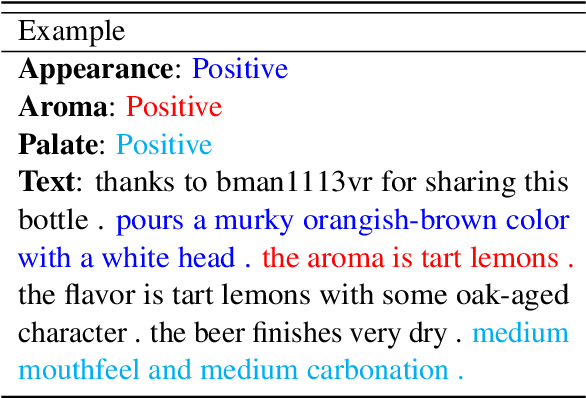
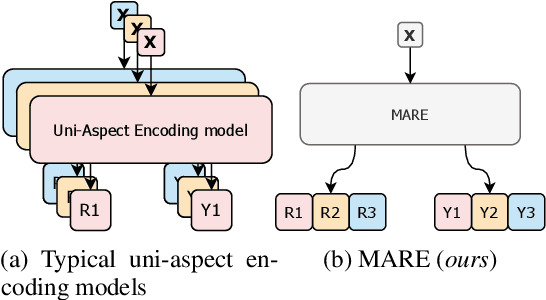
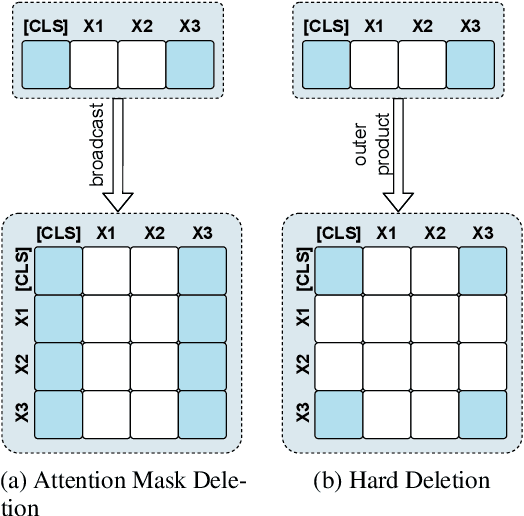

Abstract:Unsupervised rationale extraction aims to extract text snippets to support model predictions without explicit rationale annotation. Researchers have made many efforts to solve this task. Previous works often encode each aspect independently, which may limit their ability to capture meaningful internal correlations between aspects. While there has been significant work on mitigating spurious correlations, our approach focuses on leveraging the beneficial internal correlations to improve multi-aspect rationale extraction. In this paper, we propose a Multi-Aspect Rationale Extractor (MARE) to explain and predict multiple aspects simultaneously. Concretely, we propose a Multi-Aspect Multi-Head Attention (MAMHA) mechanism based on hard deletion to encode multiple text chunks simultaneously. Furthermore, multiple special tokens are prepended in front of the text with each corresponding to one certain aspect. Finally, multi-task training is deployed to reduce the training overhead. Experimental results on two unsupervised rationale extraction benchmarks show that MARE achieves state-of-the-art performance. Ablation studies further demonstrate the effectiveness of our method. Our codes have been available at https://github.com/CSU-NLP-Group/MARE.
 Add to Chrome
Add to Chrome Add to Firefox
Add to Firefox Add to Edge
Add to Edge